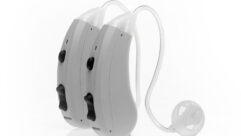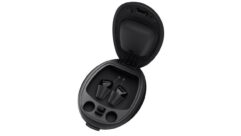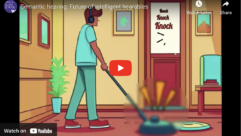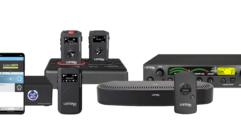Hearing for all
Jan 1, 2000 12:00 PM,
Russell Gentner
Considerations for designing and installing assistive listening systems inlarge venues.
Have you ever attended an event in a stadium or arena, and because youcould not hear the sound system, the experience was disappointing? As youare well aware, it is a responsibility for our industry to specify andinstall systems that provide sufficient sound levels to all participants,no matter where they sit. At almost any large public event, no matter howfantastic the audio system is, it is not satisfactory for all attendees.For many, hearing adequately is just not possible, and the experience isalmost always disappointing. One reason is that more than 10% of ourpopulation is physically hearing impaired. Another is that many people withnormal hearing cannot hear the sound system for reasons inherent to loudenvironment noise and other distractions in large-venue events.
To help the 10% of our population that is hearing impaired, the Americanswith Disabilities Act (ADA) was created to ensure equal access tofacilities for all people. This legislation requires most public facilitiesto provide assistive listening devices (ALD) for 4% of seating capacity.For example, by law, a 20,000-seat stadium must have 4% of its seats ALDcapable, meaning that 800 ALD receivers are required to be available in a20,000-seat venue.
An opportunity beyond meeting the ADA
Although provision for ALDs is mandated by law for the hearing impaired,ALDs can also be used for people who are environmentally hearing impaired.For example, in a venue with a high noise level, anyone can benefit fromusing an ALD to hear commentary that would otherwise be difficult to hearover the sound system. Assistive listening devices can also benefit largevenues by serving several applications. Using the recently approved 216 MHzband, a facility’s assistive listening system can now also be used to tourpeople through the facility or transmit commentary in different languageson various frequencies. This adds greater value to an ALD system andprovides more customer service opportunities for the facility. A racetrackis a large-venue example that can benefit from an assistive listeningsystem. At a racetrack, it is difficult to hear the sound system because ofthe noise created by the event itself. Using ALDs, individuals have theopportunity to hear what is going on and even control their own audio.
Although the ADA requires such devices, and great benefits clearly can bederived from their use, few venues comply with the ADA’s 4% requirement.Worse, few of the devices are used by the very people they were designed tohelp. The main reason for this is that the general public, includinghearing-impaired people, is not aware of the availability of these devices.
A hearing-impaired person with significant hearing loss commonly uses onlya personal hearing aid with the belief that there is no alternativesolution to hear the sound system in a public facility. The drawback to ahearing aid is it cannot separate environmental noise from the publicaddress. An ALD allows the user to control volume and the desired mix ofenvironment and sound system audio.
We should encourage large-venue customers to use such promotional tools asthe examples described below to promote this benefit for both thehearing-impaired and general populations. Awareness will significantlyincrease the value of an ALD system for you as the contractor, for thefacility and for someone who could use the device.
Transforming potential into reality
The first step is to communicate to your customers their ALD requirementsgoverned by law, but more importantly, communicate to facilities thebenefits of offering ALDs to event goers. The benefits are that anyonephysically or environmentally hearing-impaired can now clearly hear soundsystem audio by simply asking for a facility-provided receiver.
Offering an ALD system is more than simply storing receivers behind thecounter. The availability of receivers should be clearly communicated topeople who attend such events through signs, PA announcements and easyaccess to the devices. A good example of easy access is to provide adispensing station at each event. ALD manufacturers supply signs forplacement in public facilities. Request enough signs to place one at eachfacility entrance. In today’s venues, rarely is the availability of ALDseasily visible to event goers. The second step involves providing ALDsystems that work reliably, offer excellent sound performance and stand upto the rigors of public use.
Providing ALD systems for large venues is challenging at best. Consider thesize and natural obstacles. Infrared (IR) systems are impractical. FMsystems are almost always required for range and outdoor use requirements.The FCC has allocated two possible frequency bands for assistive-listeningtransmission. Most of the systems installed in the past have been 72 MHzunits. Just recently, the FCC opened a new band for assistive listening at216 MHz. This new band can also be used for language translation and tourgroups.
Two steps must be considered to provide effective ALD systems in largevenues. The first step is to design systems that cover every seat in thehouse and cover multiple ALD applications. Some venues, for example, haveALD systems for the sound system, tour groups, language translation and thepress. The second step is to install and implement a system that stands thetest of time.
Designing the system
When designing ALD systems, you should consider interference, range,durability and features of the ALD itself. Also, try to anticipate all theancillary uses for ALDs in the specific venue. Ultimately, the mostimportant decision is to decide whether to stick with the 72 MHz or move tothe new 216 MHz band.
Interference and the anticipation thereof is critical to the success of anALD system. The only sure way to evaluate interference is to get a 72 MHzand 216 MHz system and evaluate them for yourself. It is probable that inlarger cities, you will find interference on one or more channels. At 72MHz, however, there is roughly 3 MHz of spectrum space to find a clearchannel, and at 216MHz, there is 1MHz of spectrum. You should be able tofind a clear channel even if you do not do a site analysis. In addition, itis possible that once a system has been installed, future sources ofinterference may rear their ugly heads, thus providing unpleasant listeningfor users and a problem for the venue and contractor. For this reason, itis a good idea to provide a system that can access multiple channels onsite.
Additionally, make it a point to determine an adequate range. Coveringevery seat in the house with sufficient RF field strength is probably themost difficult task in designing such a system. ALD systems offer roughly10 mW to 100 mW of transmit power, depending on the system and frequency.The typical unobstructed, line-of-sight range of 72 MHz systems is between500 feet (152 m) and 1,500 feet (457 m). For 216 MHz systems, the range isfrom 1,000 feet (305 m) to 3,000 feet (914 m). In addition, 216 Hz systemscan be used with more efficient antenna systems.
Although the range inherent in 216 MHz band systems appears to make them abetter solution for large venues, there are some tradeoffs. Because the 216MHz band has just recently been approved for assistive listening, it is notcompatible with existing systems that may already be in use at somefacilities; for hearing-impaired people who own their own 72 MHz receivers,the system will also not be compatible. Further, because 216 MHz is a thirdthe wavelength of 72 MHz, receivers are much more susceptible to multi-pathdropouts. Multi-path occurs when two reflected RF signals add out-of-phaseand create a hole in the RF signal coverage. This usually results in ashort squelch tail heard by the user as he moves through the multi-path.For users who are stationary (and most are), simply moving the receiver afew inches will minimize the effects of multi-path. Finally, at the higherfrequency, coax losses are roughly double what they are for 72 MHz (seetable 1). For this reason, it is important to keep the coax runs as shortas possible and use low-loss coax. (This is true for any RF system in whichyou want to minimize loss in the coax.) A general rule of thumb for 216 MHzsystems is to use RG58 coax for all runs 50 feet (15 m) or less and RG8 forsystems more than 50 feet.
Another important consideration when choosing an ALD system is to choose anALD receiver that will withstand wear and tear and has the features thatwill make the product easy to use for the facility and its users. Ensurethe belt clip is looped or provides some other type of positive hookingmechanism to prevent the receiver from accidentally dropping to the floor.This is the leading cause of damage to receivers.
You will also want to specify an ALD that can easily and quickly bereturned if interference ever does crop up. Some systems need to bereturned to the manufacturer for returning if they are not tunable in thefield, which can be a hassle for contractors and facilities.
An ear loudspeaker that secures comfortably to one ear is an excellentearphone option for large-venue events. The listener can hear peoplesitting around them as well as the commentary through the ALD. If, however,you are specifying a headset, check to make sure that the ALD will acceptstereo and mono. Imagine plugging your Walkman headset into an ALD andgetting the audio in only one ear. How frustrating.
A final consideration is battery type. If you specify alkaline batteries,you will save your customer money up front. For systems that are constantlyin use, however, you will probably want to consider using rechargeablebatteries, which will easily pay for themselves. More importantly, theywill save the time and frustration of having to change disposable batterieswhen they die.
Multiple ALD applications in one facility
Many venues can use ALDs for the press and for people in the press box.Also, ALDs can be used for language translation often required for certainevents. Even consider the use of ALDs to tour people through the venue.Whether it is VIPs, the press or the local elementary class, large eventvenues are constantly giving guided tours. In all cases, you will need toaddress potential interference. To that end, you may need to mix and matchfrequency bands at 72 MHz and 216 MHz. It is possible to operate onmultiple frequencies. At 72 MHz, you can operate approximately 10simultaneous channels, while at 216 MHz, you will be limited to fivechannels. Still, 15 potential interference-free channels in one venue willprovide for several application opportunities.
Installing the system
Essentially, there are three main tasks when installing an ALD system, thefirst of which is installing the antenna. The antenna must be mounted in alocation that will provide the best coverage to every seat in the house.This is usually in the center above the seats, if possible. Attempt tolocate the antenna in a place that presents no physical obstruction to theseats. (See Figure 1.) The antenna should be mounted so that the RF signalis disbursed to the seats and not to the roof. One of the most popularantennas used at 72 MHz is a dipole antenna, which can be mounted easily toa wall or pole. At 216 MHz, a ground plane antenna is a good choice. Itshould be mounted ground plane up, and the antenna pointed down if it ismounted above the seats. (See Figure 2.) Remember to keep the coax lengthas short as possible. In an outdoor facility, make sure you useweather-resistant RF connectors. It is a good idea to seal all connectionswith silicon once the installation has been proven.
Next comes mounting the transmitter. Locate the transmitter in a positionwhere no one can tamper or interfere with its operation. Most ALDmanufacturers offer a rack-mount kit for their products, and you can alsospecify a security cover to prevent tampering.
Last is connecting to the sound system. If possible, use a balancedconnection to reduce potential ground loops. If you are running longdistances (more than 20 feet or 6 m) make sure you use a low-impedance,balanced audio source to minimize distributed capacitance that will rolloff the high frequencies. Make sure that you set the levels on the ALDtransmitter under normal operating conditions.
ALD repeaters
When installing ALD systems in large venues, you may come across problemsinvolving getting the audio from the sound system to the ALD transmitterwithout running cable there or dealing with a venue so large that one ALDsystem just won’t cover it. A unique way to solve both of these dilemmas isto use an ALD repeater system. Here is how it works. Connect the soundsystem to a 72 MHz transmitter. For situations in which cable cannot be run(see Figure 4), simply use a receiver to pick up the signal and thenretransmit the audio to the facility on a 216 MHz transmitter. In a largeenvironment (see Figure 5), locate as many receiver and transmitterrepeaters as needed to cover the facility. Make sure users are givenmultiple channel receivers so they can tune to the channel in their area ofthe facility.
Helping people further enjoy large venue events is a great opportunity forsound contractors. Whether providing tools to help people hear thecommentary, provide for language translation, communicate to the press orgive guided tours; assistive listening devices are importantproblem-solvers for large venues.










